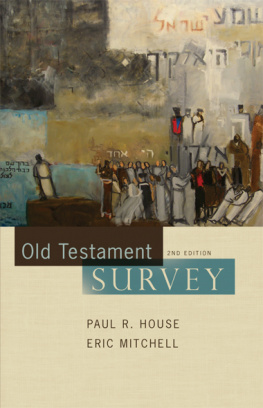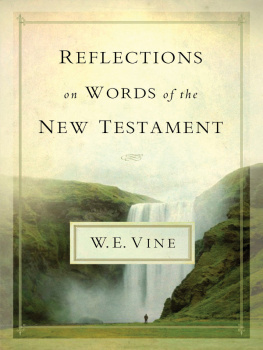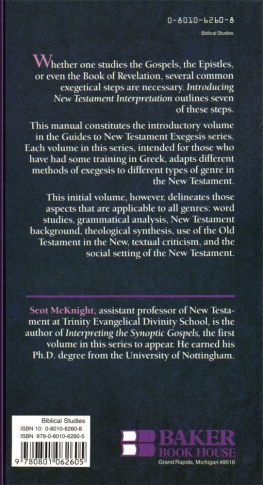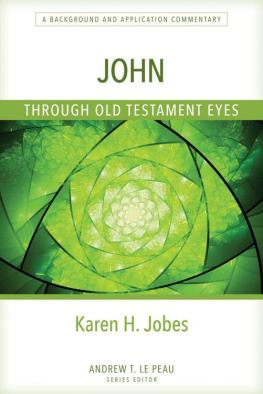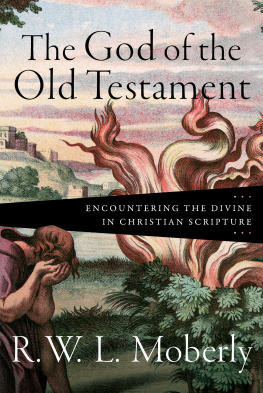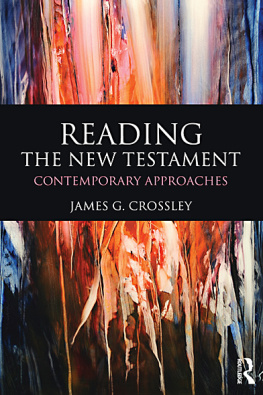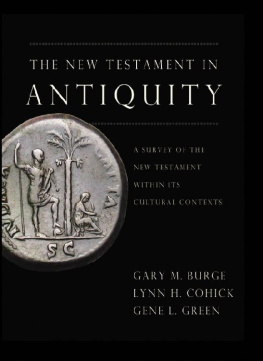ZONDERVAN
The Time Between the Old and New Testaments
Copyright 2000, 2007 by Halleys Bible Handbook, Inc.
Previously published in Halley's Bible Handbook with the New International VersionDeluxe Edition
All rights reserved under International and Pan-American Copyright Conventions. By payment of the required fees, you have been granted the non-exclusive, non-transferable right to access and read the text of this e-book on-screen. No part of this text may be reproduced, transmitted, downloaded, decompiled, reverse engineered, or stored in or introduced into any information storage and retrieval system, in any form or by any means, whether electronic or mechanical, now known or hereinafter invented, without the express written permission of Zondervan.
ePub Edition August 2012: ISBN 978-0-310-49628-1
Requests for information should be addressed to:
Zondervan, Grand Rapids, Michigan 49530
The Library of Congress has cataloged the complete volume as:
Halley, Henry Hampton, 1874 1965.
Halleys Bible handbook with the New International Version / by Henry H. Halley.
p. cm.
Includes bibliographical references and index.
ISBN 978-0-310-22479-2 (hardcover)
1. BibleCommentaries. I. Title.
BS491.2.H355 2000
220.77dc 021 99-059615
All Scripture quotations, unless otherwise indicated, are taken from The Holy Bible, New International Version. NIV. Copyright 1973, 1978, 1984 by International Bible Society. Used by permission of Zondervan. All rights reserved.
Any Internet addresses (websites, blogs, etc.) and telephone numbers in this ebook are offered as a resource. They are not intended in any way to be or imply an endorsement by Zondervan, nor does Zondervan vouch for the content of these sites and numbers for the life of this book.
All rights reserved. No part of this publication may be reproduced, stored in a retrieval system, or transmitted in any form or by any means--electronic, mechanical, photocopy, recording, or any other--except for brief quotations in printed reviews, without the prior permission of the publisher.
Cover design: Ron Huizinga
T he world of the New Testament is very different from that of the Old Testament. The changes that took place over four centuries affected every area of life. Many of these changes are interrelated.
Political and Cultural Changes
- The Romans, instead of the Persians, now control Palestine.
- Greek thought and culture (Hellenism), rather than the gods of the Canaanites such as Baal and Molech, now threaten to derail Gods people.
Geographical Changes
- Palestine is divided into Judea, Galilee, Samaria; on the east side of the Jordan River are Perea and the Decapolis. Furthermore, there are now (sometimes sizable) Jewish communities in most major cities of the Roman Empire, each with its own synagogue. This is referred to as the Diaspora, or dispersion.
Religious Changes
- Religious parties: The parties of the Pharisees and Sadducees (as well as the political parties of the Zealots and Herodians) did not exist in the Old Testament.
- Religious functionaries:Teachers of the Law (scribes) and rabbis (teachers) play a prominent role. The chief priests as a group with its own identity is not found in the Old Testament.
- Religious institutions: The temple and the temple area have been transformed from the modest structure built by the postexilic Jews into a magnificent complex. In addition, each town now has a synagogue, a place for worship and study of the Word of God.
Language and Writings
- The common language in Palestine is no longer Hebrew but Aramaic. The language of commerce and communications throughout the Roman Empire is Greek.
- These changes in language necessitated translations of the Hebrew Bible (our Old Testament): the Septuagint, a Greek translation, and the Targums, Aramaic paraphrases.
We will look at each of these in more detail.
A. Four Centuries of Political Change
1. The Persian Period, 430332 B.C.
The story of the Old Testament ends around 430 B.C. with the prophet Malachi. The Babylonians, who had destroyed Jerusalem in 586 B.C., had been conquered by the Medes and Persians. The Persian king Cyrus allowed the Jews to go back to Jerusalem in 536 B.C. Under Ezra and Nehemiah, the temple and the city walls were rebuilt. Thus, at the close of the Old Testament, Judah was a Persian province.
Not much is known of Jewish history during this period, except that Persian rule was, for the most part, mild and tolerant.
2. The Greek Period, 331167 B.C.
Up to this time, the great powers of the world had been in Asia and Africa. But looming ominously on the western horizon was the rising power of Greece.
The beginnings of Greek history are veiled in myth. It is thought to have begun about the 12th century B.C., the time of the biblical book of Judges. The Trojan War, immortalized in Homers Iliad and Odyssey, took place around 1000 B.C.the age of David and Solomon.
The beginning of authentic Greek history has usually been reckoned from the first Olympiad in 776 B.C. (which is within a few years of the founding of the city of Rome, which according to tradition took place in 753 B.C.). Greek culture and art were spectacularly original and creative (unlike later Roman art, which was much more severe and imitative). Greek culture reached its zenith in the city of Athens in the 5th century B.C., the Golden Age of Greece. This was the era of the great statesmen, philosophers, and dramatists.
This Golden Age of Greece was approximately the same period during which the temple and walls of Jerusalem were rebuilt under Zerubbabel, Ezra, and Nehemiah after the Babylonian exile.
Alexander the Great was the son of King Philip of Macedonia, north of Greece. In 336 B.C., at the age of 20, he assumed command of the Greek army and swept eastward over the lands that had been under the rule of Egypt, Assyria, Babylon, and Persia. By 331 B.C. the whole world lay at his feet.
When Alexander invaded Palestine in 332 B.C., he showed great consideration toward the Jews, spared Jerusalem, and offered the Jews inducements to settle in Alexandria, Egypt. He established Greek cities all over his conquered domains, with the intent of spreading Greek culture and the Greek language throughout the world. After a brief reign, he died in 323 B.C. at the age of 33. His empire did not last, but his dream did: Greek language and culture (Hellenism) would dominate the world for many centuries.
Under Egyptian Rule (The Ptolemies)
After Alexanders death, his empire was divided among four of his generals. Palestine lay between the two eastern sections of the empire, Syria and Egypt. Syria went to Seleucus (who was the first of the Seleucid dynasty), Egypt to Ptolemy (the first of the Ptolemies). Palestine went first to Syria, but shortly thereafter passed to Egypt (301 B.C.) and remained under Egyptian control until 198 B.C.
Under the Ptolemies the condition of the Jews was mainly peaceful. During this period, Alexandria in Egypt became an influential center of Judaism.
Under Syrian Rule (The Seleucids)

King Antiochus the Great of Syria recaptured Palestine in 198 B.C., which thus passed back to the kings of Syria, the Seleucids. Initially the Seleucids were tolerant toward the Jews, but that soon changed.





